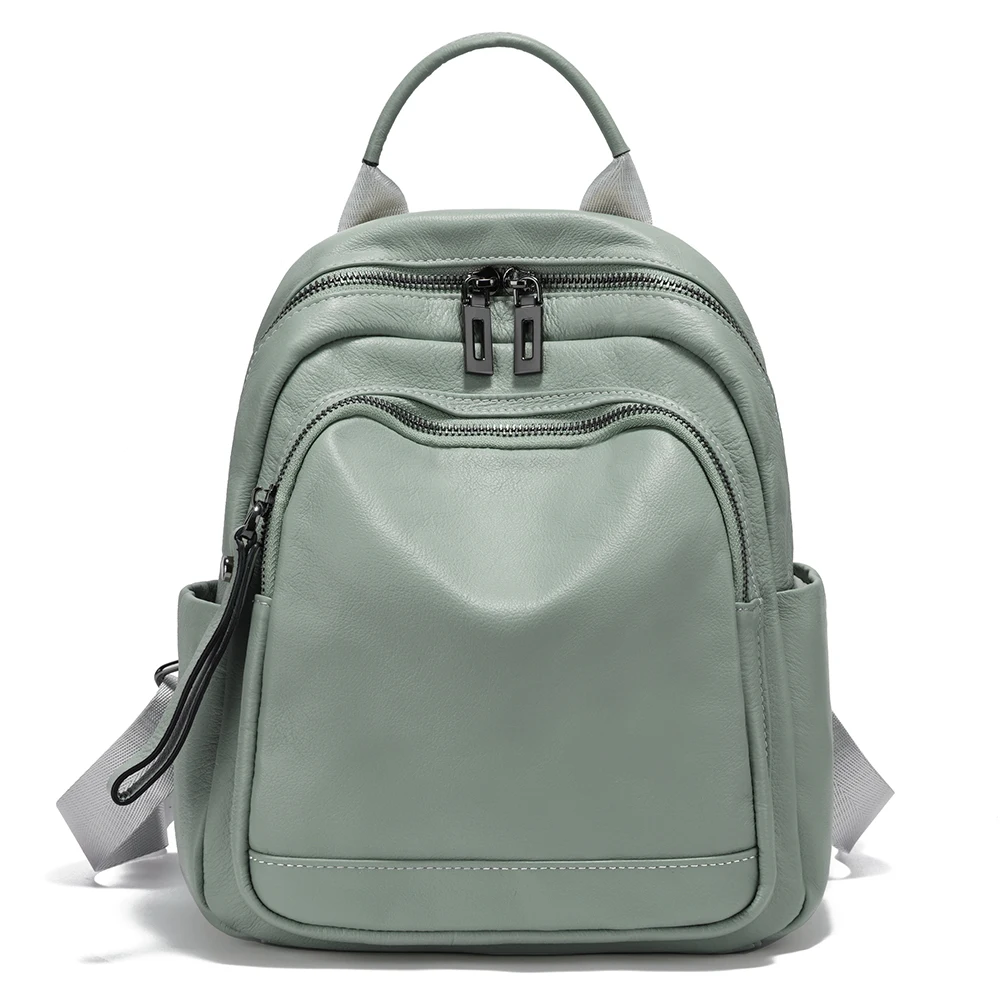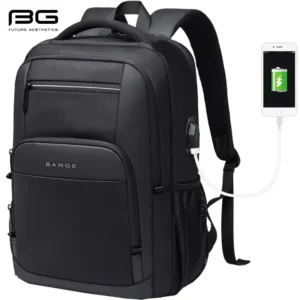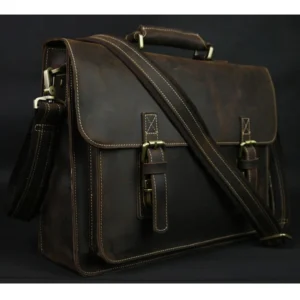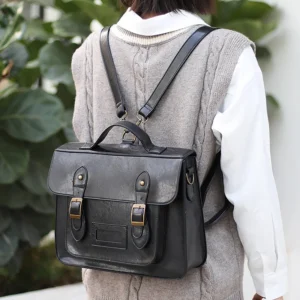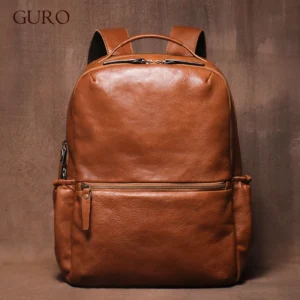Why Organization is Essential for Your Leather Bag
A well-organized leather bag isn’t just about neatness—it’s about functionality, efficiency, and presenting yourself as a man who pays attention to details. The transformation from a chaotic jumble of items to a streamlined, purposeful arrangement can significantly impact your daily routine and professional image.
When your leather bag is properly organized, you’re not just carrying your belongings; you’re carrying them with intention. This mindfulness about organization translates into tangible benefits that extend beyond simple tidiness.
The core benefits of maintaining an organized leather bag include:
- Professional image enhancement – Walking into a meeting and smoothly retrieving exactly what you need projects confidence and competence
- Protection of valuables – Proper organization prevents your laptop, tablet, and other electronics from being scratched or damaged
- Time efficiency – Never waste precious minutes digging through a disorganized bag when you need something quickly
- Extended bag lifespan – Even weight distribution and proper item placement prevent strain on seams, handles, and the leather itself
Picture yourself in an important client meeting, smoothly reaching into your bag to retrieve a document exactly when needed, versus frantically searching through a jumble of items while everyone waits. The difference is noticeable and impactful.
Leather care experts consistently emphasize that organization isn’t just about appearance—it directly impacts how long your versatile leather bags for men will last. When items shift around chaotically, they create uneven pressure points that can permanently misshape your bag over time. Different men’s leather backpack styles require specific organizational approaches to maintain their distinctive shapes and functionality.
Phase 1: Clearing the Canvas – The Essential Declutter
The journey toward perfect organization begins with a clean slate. Empty your bag completely—yes, every single pocket and compartment. This step might seem obvious, but it’s surprising how many items can hide in corners and forgotten pockets.
Once everything is laid out before you, it’s time to evaluate each item using the “Keep, Discard, Relocate” methodology:
Keep: Essential items you use regularly that truly deserve space in your bag.
Discard: Outdated items, trash, and things that don’t serve a purpose (like those months-old receipts, broken pens, or business cards from people you’ll never contact).
Relocate: Items that might be useful but don’t need to travel with you daily. These should find homes elsewhere.
Men typically carry several unnecessary items that create bulk and disorganization. Common culprits include multiple pens when one or two would suffice, countless loose receipts, business cards you’ll never use, or “just in case” items that rarely, if ever, serve their purpose.
To prevent future clutter buildup, establish a weekly maintenance routine. Every Friday afternoon, take five minutes to remove accumulated items and reset your bag to its organized state. This simple habit prevents the slow creep of disorganization that occurs over time.
Starting with decluttering allows you to understand the true functionality of men’s leather bags and how to maximize their utility through thoughtful organization.
Strategic Item Categorization for Men’s Essentials
Once you’ve decluttered, categorizing your remaining essentials creates a mental framework for organization. For most men, items fall into four key categories:
Technology & Gadgets
* Laptop/tablet and protective sleeve
* Smartphone (if not carried in pocket)
* Headphones or earbuds
* Charging cables and adapters
* Power bank
* Small tech accessories (USB drives, etc.)
Business & Documents
* Notebook and/or planner
* Important documents and folders
* Business cards (both yours and collected ones)
* Pens and writing instruments
* Small calculator or other specialized tools
Personal Daily Essentials
* Wallet (if carried in bag rather than pocket)
* Keys (consider a key organizer or clip)
* Sunglasses in protective case
* Medications or supplements
* Hand sanitizer or wipes
Emergency & Miscellaneous
* Small first-aid items (bandages, pain relievers)
* Breath mints or gum
* Compact umbrella or rain protection
* Snack (non-perishable energy bar)
* Handkerchief or microfiber cloth
The minimalist approach suggests evaluating each item with a simple question: “Have I needed this in the past two weeks?” If the answer is no, it might not deserve permanent residence in your bag. A finance professional might prioritize document organization and calculator access, while a creative professional might need quick access to sketching tools and digital devices.
Understanding these categories will help you implement the techniques covered in our organizing leather backpack guide more effectively. This categorization system lays the groundwork for your physical organization strategy.
Understanding Your Leather Bag’s Architecture
Before you begin placing items back into your bag, take time to understand its unique organizational structure. Different leather bags feature distinct compartment configurations, each with specific organizational strengths and limitations.
Most men’s leather bags include:
- Main compartment (usually the largest space)
- Laptop sleeve or padded section
- Several zippered pockets of various sizes
- Multiple slip pockets for flat items
- Pen loops or small item holders
- External quick-access pockets
To maximize organization, assess your bag’s features by identifying each compartment’s natural strengths. A padded laptop sleeve obviously accommodates your computer but might also hold folders or documents. Smaller zippered pockets protect items that might otherwise get lost in the main compartment.
Identify any organizational weaknesses in your bag’s design. Does it lack dedicated spaces for cables or small tech accessories? Is there insufficient protection for fragile items? Understanding these limitations allows you to compensate with organizational tools later.
The key is matching your bag’s architecture to the item categories you established earlier. For example, technology items might all belong in the main compartment and laptop sleeve, while personal essentials fit perfectly in quick-access external pockets.
Summit Carry designs incorporate thoughtful organizational features like padded laptop compartments, strategically placed accessory pockets, and durable internal dividers that make organization more intuitive. Understanding the ultimate guide to leather backpacks compartments can help you better utilize every inch of space in your bag.
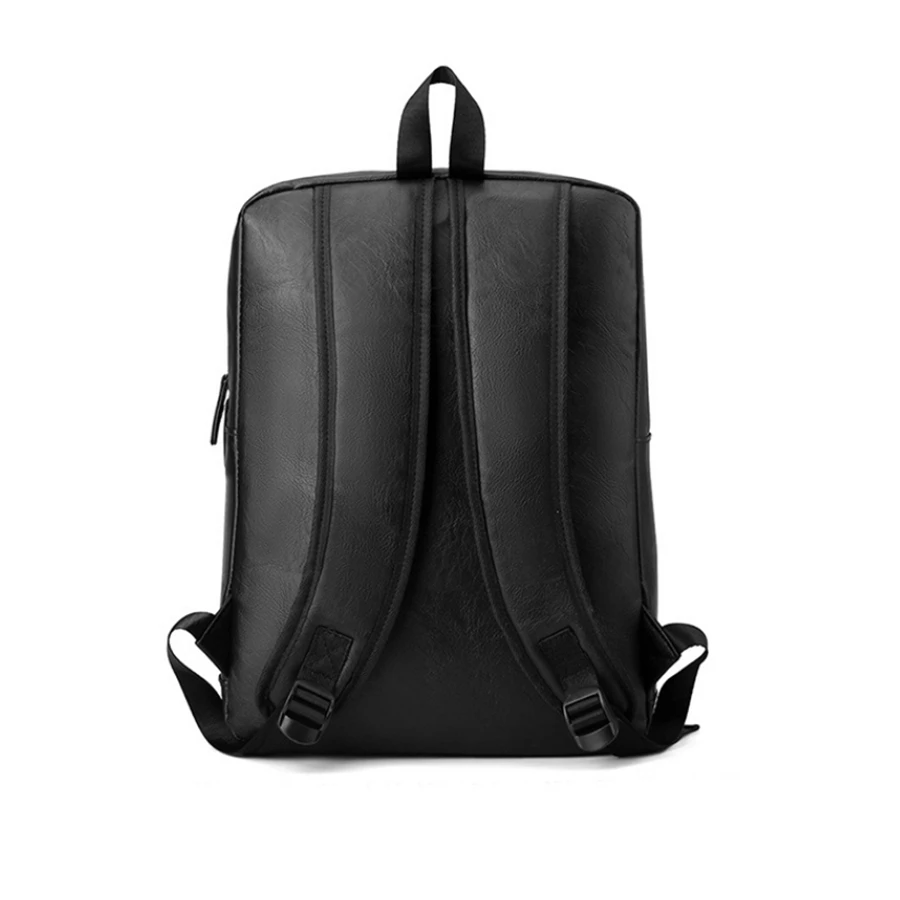
The Strategic Packing Technique: Layering & Priority Access
With your items categorized and your bag’s architecture understood, it’s time to implement a strategic packing technique based on layering and priority access.
The three-layer approach optimizes both protection and accessibility:
Bottom layer: Place less frequently used items here—perhaps reference materials, emergency supplies, or seasonal items. This foundation should be relatively flat to create stability.
Middle layer: This is where core essentials go. Your laptop (in its sleeve), important documents, and larger electronics belong here. These items benefit from the protection of being surrounded by other layers.
Top layer: Reserve this space for quick-access items you’ll need throughout the day—pens, business cards, chargers, and personal items. The goal is to retrieve these without disturbing the other layers.
Proper weight distribution is crucial for both bag longevity and comfortable carrying. Center heavy items like laptops along the back panel rather than allowing them to sag toward the front. Distribute weight evenly from left to right to maintain your bag’s shape and reduce strain on your shoulder or back.
Create a “priority access zone” near the top or in external pockets for the 3-5 items you reach for most frequently. This might include your phone charger, business card case, or a small notebook.
The layering approach should adapt to your day. When traveling, bottom items might include travel documents you’ll need at specific checkpoints. During a standard workday, your priority access zone might focus on meeting essentials.
Implementing these packing essentials for leather day bags will ensure everything has a place and remains easily accessible when needed.
Essential Organization Tools for the Modern Man’s Bag
Even the most thoughtfully designed leather bag benefits from organizational accessories that enhance its natural structure. These tools aren’t about adding unnecessary complications—they’re about creating intuitive systems that maintain order.
Bag Inserts and Organizers:
* Felt or canvas organizers that add vertical structure and dividing walls
* Slim laptop sleeves that provide additional protection
* Bag shaper inserts that maintain structure while adding organizational dividers
When selecting inserts, choose materials that complement your leather bag—felt provides protection without adding weight, while canvas offers durability with minimal bulk. The organizer should enhance your bag’s existing structure rather than forcing a new organization system entirely.
Specialized Pouches and Cases:
* Tech pouches with elastic loops for cables and small electronics
* Leather document folders that protect papers while keeping them flat
* Slim toiletry pouches for grooming essentials
* Key organizers or clips that prevent keys from scratching other items
Cable Management Solutions:
* Silicone cable ties or leather cord wraps
* Small pouches with multiple compartments for various cables
* Earphone cases that prevent tangling and damage
The key is selecting tools that enhance organization without adding significant bulk. Premium leather bags deserve equally thoughtful accessories—consider leather or canvas options that complement your bag’s aesthetic while providing functional benefits.
These organizational tools not only protect your belongings but also the interior of your bag. Cables are particularly problematic when left loose—they can scratch leather interiors and create unnecessary tangles that waste time and cause frustration.
Our collection of men’s leather backpacks features designs that work harmoniously with these organization tools, creating a comprehensive system for keeping your essentials in perfect order.
Customizing Organization by Leather Bag Style
Different leather bag styles demand unique organizational approaches to maximize their specific designs. Let’s explore organization strategies customized for popular men’s bag styles:
Briefcase Organization:
The professional briefcase typically features a structured design with document-focused organization. Maximize this style by using the natural dividers for document separation—client folders in one section, personal documents in another. Create a system where your most frequently referenced files are positioned at the front for easy access. Reserve side pockets for business cards, pens, and small tech accessories. Keep your laptop centered in its dedicated compartment to maintain the bag’s balanced shape and professional appearance.
Messenger Bag Organization:
Messenger bags feature a more horizontal organization with flap access. This design excels at quick retrieval but requires thoughtful organization to prevent items from shifting during carry. Use the front pockets for absolutely essential quick-access items. The main compartment benefits from vertical dividers or pouches to prevent contents from sliding to one side—a common issue with messenger bags. Position weight toward the back panel (closest to your body) for comfort during extended carrying.
Leather Backpack Organization:
Backpacks offer vertical organization with top-down access. Take advantage of this structure by creating zones: top zone for quick-access items, middle zone for daily essentials, and bottom zone for less-frequently used items. Many backpacks include side pockets—perfect for water bottles or items you need without removing the bag. Maintain even weight distribution between left and right sides to preserve the bag’s shape and ensure comfortable carrying.
Overnight/Duffle Organization:
For overnight bags, compartmentalization is crucial. Keep clothing folded or rolled on one side, toiletries contained in a waterproof pouch, and electronics/valuables secured in padded sections. Use shoe bags to prevent soiling other contents, and position toiletries in easily accessible pockets for security checkpoint removal.
When switching between bag styles, take time to reconsider your organization strategy rather than simply transferring items from one bag to another. Each style has unique organizational strengths that should be leveraged.
Our selection of leather briefcase backpacks combines the best organizational features of both styles for professionals who appreciate versatility alongside organization.
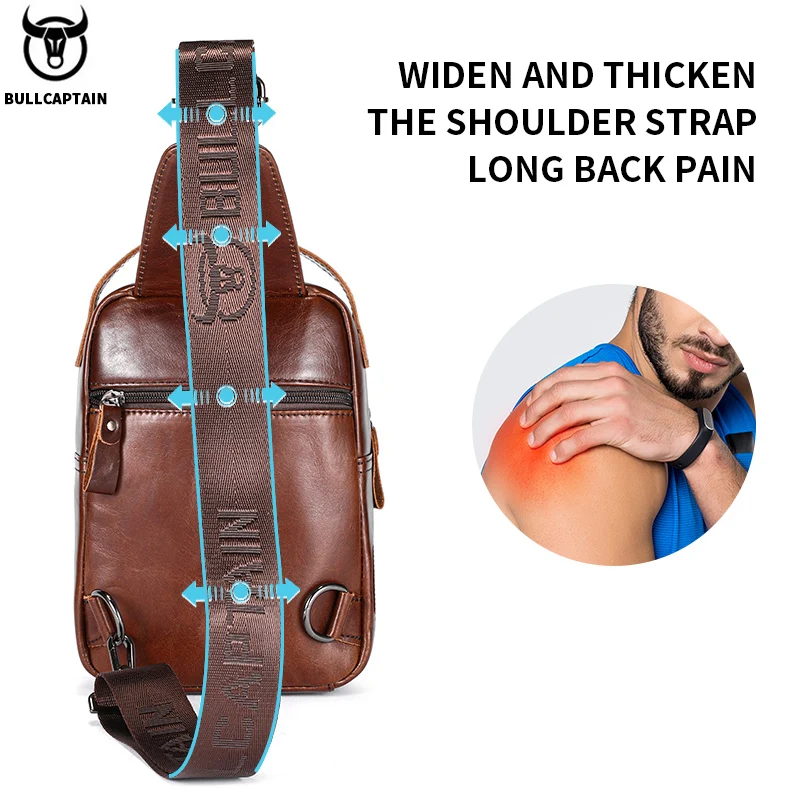
Daily and Weekly Maintenance Routines
Organization isn’t a one-time achievement—it’s an ongoing practice supported by simple maintenance routines:
End-of-Day Quick Maintenance (2 minutes)
* Remove and discard obvious trash (receipts, wrappers, etc.)
* Return items to their designated places if they’ve migrated
* Check for any items that should be removed from the bag
* Ensure cables are properly wrapped and secured
* Verify that your priority items for tomorrow are in place
Weekly Thorough Organization Check (10 minutes)
* Completely empty the bag and wipe down the interior
* Evaluate all contents using the Keep/Discard/Relocate method
* Check organizational tools for wear or damage
* Reorganize according to upcoming week’s priorities
* Repack using the layering system
Regular maintenance prevents small disorganization issues from becoming major problems. For instance, loose receipts or business cards can quickly accumulate in corners if not addressed daily.
Consider seasonal rotations for certain items—swap out sunglasses for gloves in winter, or exchange the light raincoat for more substantial weather protection. This keeps your bag relevant to current needs without unnecessary bulk.
Proper maintenance extends beyond organization to the leather itself. Understanding leather backpack conditioning guidelines ensures your bag remains supple and protected while maintaining its organizational integrity.
Protecting Your Investment: Organization for Leather Bag Longevity
Proper organization directly impacts the longevity of your leather bag—an important consideration for such a significant investment. Beyond convenience, thoughtful organization protects your bag in several ways:
Interior damage prevention starts with proper item placement. Sharp objects should always be contained in protective cases rather than loose in pockets where they can scratch or tear the lining. Pens should always have caps secured to prevent ink stains that can be nearly impossible to remove from leather or fabric linings.
Structural integrity depends heavily on weight distribution. When items shift to one side of your bag, they create uneven pressure that can permanently stretch or deform leather over time. This is particularly important for softer, more supple leather varieties that conform more readily to their contents.
Zippers, handles, and seams face the greatest stress during daily use. Overloading compartments forces zippers beyond their capacity, potentially causing teeth to separate or pulls to break. Similarly, placing excessive weight in a bag without proper distribution creates undue stress on handles and seams, the most common failure points in even high-quality leather bags.
Protect your investment in men’s leather laptop backpacks by organizing in a way that prevents stress on any single component of the bag. Even the finest leather and craftsmanship can be compromised by poor packing habits over time.
14 Inch Leather Laptop Backpack, Brown Leather Backpack, Men's Leather Backpack, Vintage Leather Backpack
Price range: $177.28 through $199.12 Select options This product has multiple variants. The options may be chosen on the product pageDesigner Men's Backpack, Men's Leather Laptop Backpack, Men's Leather Work Backpack
Price range: $158.04 through $160.04 Select options This product has multiple variants. The options may be chosen on the product page15 Inch Leather Laptop Backpack, Leather Briefcase Backpack
$332.96 Select options This product has multiple variants. The options may be chosen on the product page17 Inch Leather Laptop Backpack, Men's Leather Travel Backpack, Men's Leather Work Backpack
Price range: $106.28 through $143.88 Select options This product has multiple variants. The options may be chosen on the product pageWomen's Leather Backpack, Women's Leather Work Backpack
Price range: $119.36 through $128.52 Select options This product has multiple variants. The options may be chosen on the product pageFull Grain Leather Backpack, Men's Leather Laptop Backpack, Men's Leather Work Backpack
$353.46 Select options This product has multiple variants. The options may be chosen on the product page
Beyond the Basics: Advanced Organization Strategies
Once you’ve mastered the fundamental organization techniques, consider these advanced strategies to further optimize your leather bag experience:
Context-based organization adapts your setup based on different scenarios. Create “loadout templates” for common situations—a business trip configuration might prioritize documents and multiple device chargers, while a daily office setup might focus more on workspace essentials and lunch containers. Having mental presets for different contexts allows for quick reconfiguration.
The minimalist approach challenges you to critically evaluate each item’s actual necessity. Many men carry items for weeks without ever using them. Try this exercise: mark each item with a small piece of removable tape. Remove the tape only when you actually use that item. After two weeks, consider whether unmarked items truly deserve space in your daily carry.
Digital alternatives can dramatically reduce physical bulk. Apps have replaced many traditional paper items—business card scanners, digital notebooks, mobile payment methods, and cloud storage for documents can all lighten your load significantly.
Season-specific organization acknowledges that your needs change throughout the year. Summer might require sunscreen and sunglasses, while winter demands gloves and cold medication. Quarterly reviews of your bag contents ensure you’re carrying what’s relevant to the current season.
Professional men who have mastered bag organization often describe it as a personalized system that evolves over time. The most successful approach combines these principles with your specific needs and preferences.
Our guide to perfect leather backpacks for daily organization provides additional insights for those looking to further refine their organizational system.
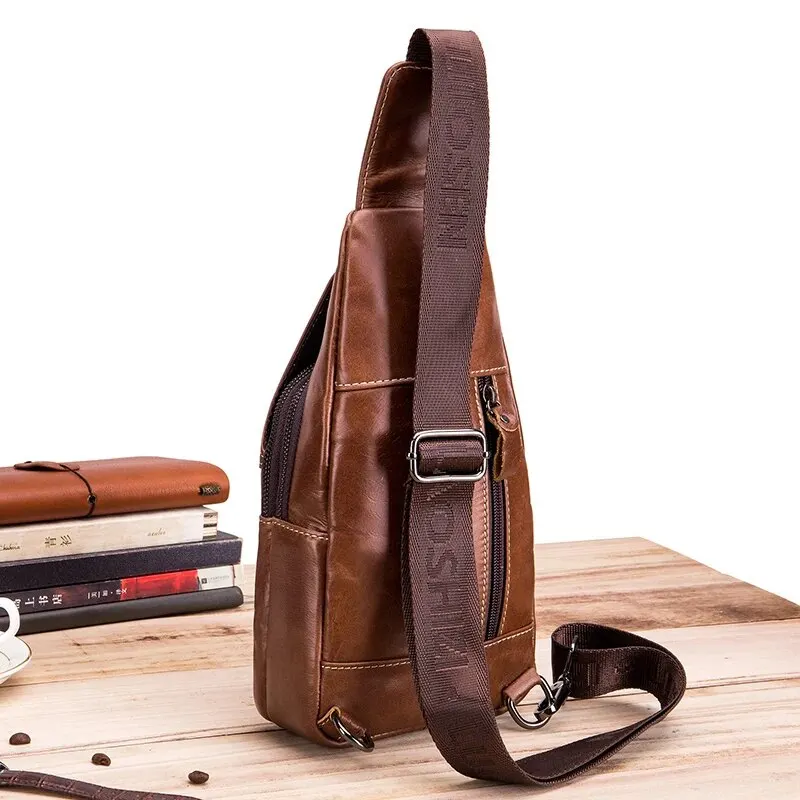
Final Thoughts: The Organized Man’s Advantage
The transformation from a chaotic leather bag to a well-organized system delivers benefits that extend far beyond mere convenience. There’s a subtle psychological advantage to knowing exactly where everything is—it provides a sense of control and preparedness that influences how you approach your day.
An organized bag reflects an organized mind. In professional settings, this attention to detail doesn’t go unnoticed. The man who can smoothly retrieve exactly what’s needed without fumbling demonstrates a competence that extends to other aspects of his work.
Perhaps most importantly, external organization contributes to mental clarity. When your physical tools and resources are systematically arranged, your cognitive resources are freed for more important matters. You’re no longer wasting mental energy wondering where things are or if you’ve forgotten something essential.
The organization system you’ve developed through these principles should ultimately be personalized. What works for one man may not work for another—your profession, daily activities, and personal preferences all influence the ideal organization strategy for your needs.
As you implement these techniques with your leather bag, remember that organization isn’t about perfection—it’s about creating systems that enhance your efficiency and protect your investment. Our collection of leather work backpacks and men’s leather work backpacks are designed to complement these organizational principles, providing the perfect foundation for your personalized system.
The organized man doesn’t just carry a bag—he carries a purposeful, efficient system that supports his daily mission, whatever it may be.
